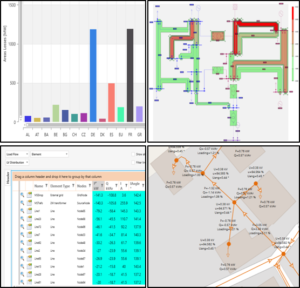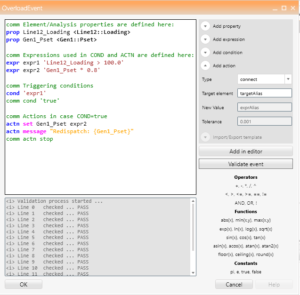Load flow
The Load Flow calculation is the most fundamental analysis module and has suitable algorithms for Distribution, Transmission, Generation and Industrial Networks. Any type of electrical power system can be modelled, such as 3-, 2- and 1-phase systems with neutral and earth conductor, AC and DC systems, meshed and radial networks etc. New models and features are available to satisfy the requirements of modern concepts such as Smart Grids, Renewables (PV, Wind, etc.), eMobility, Energy Markets and more. The algorithms are very robust and has a high performance.
General Characteristics
- Various calculation algorithms: Current Iteration, Newton Raphson, Extended Newton Raphson, Voltage Drop method per phase (Back/Forward Sweep method), DC Load Flow (decoupled, only active power flow)
- Extensive Transformer regulation models: Voltage control On-Load Tap changers, Power control with Phase-Shifters, irregular impedance/tap variation, I-V Compounding, Remote control etc.
- Power Electronics: HVDC, PWM and FACTS devices such as SVC, STATCOM, TCSC, UPFC
- DC networks models: DC-Batteries, DC-Voltage source, DC-Photovoltaic panels, DC cables etc.
- Various Power source models: Slack, PQ, PV, PC, SC, PI, IC with intuitive assignment.
- Control functions: Distributed Slack, Multiple Reactive Power control, Controller conflict management, Remote control
- Power interchange control between Areas/Zones defined freely by users.
- Predefined and user defined scaling factors for fast load and generation variations
- Measurement data import and Load estimation (allocation).
- Calculation of Sensitivities (PDTF-factors, Loss sensitivities, Tap sensitivities)
- Convergence and initialization control.
- Data validation and indication of equipment with erroneous parameters.
- Remedial Action (Event Definition)
- Limit violations and feasibility reporting.
Results
There are several possibilities to view and analyse the results of each calculation:
- Violated elements/nodes are highlighted.
- Table results can be sorted and filtered.
- Many visualization options (line thickness, colour ranges, pie charts etc.)
- Raw results can be exported in different formats.
- Result comparison between different scenarios.

Video: Introductory video for Load flow calculation could be found here.
Brochure: Introductory brochure for Load flow calculation could be found here.
Contingency Analysis
Contingency analysis or N-1 analysis is used to determine the security of a network. With NEPLAN Contingency Analysis module, users can evaluate the n-1 criterion. The outage list can include any element and node, and also common mode definitions are possible (simultaneous equipment failure).
The basis of the Contingency Analysis is the Load Flow calculation. All defined outages are calculated and their impact is reported in terms of violations caused.
The results can be viewed in tables and charts and the offered tools are aiding the engineers for the ranking of severity of each outage
Remedial Actions (Event Definition)
The Remedial Action Schemes (RAS) is a separate module and could be licensed with the modules Load Flow and Contingency Analysis.
The user can define custom events for a series of Load Flow calculations. With the defined events, the status of the simulated network can be controlled, e.g. dispatch generator power in case of limit violation so that the violation disappears. This module contains, beyond the standard control capability of the load flow, powerful functions to observe and control the network.



